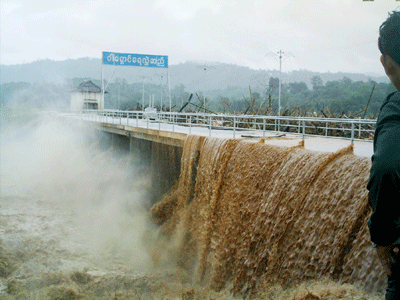When Rivers Cease to Flow
The environmental impact of mega-dams is increasing the potential for disaster in Burma
The complexity of hydropower development in Burma might be smothered by state propaganda, but hard science-based questions remain about the safety and economic viability of the country’s mega-dam projects.
 |
| Floodwaters overrunning the Washawng Dam in Burma in may 2006 shortly before it broke. (Photo: KDNG) |
How badly will the flooding and construction of the dams affect the watershed? How vulnerable is the area to earthquakes? How would rapid melting of Himalayan glaciers or radical fluctuations in rainfall, as a result of climate change, affect reservoir recharge and electricity generation? Are the dam builders in Burma asking any of these questions?
Watershed management
In hydropower terms, a watershed is the area between mountain ridges through which water flows to fill a dam reservoir. A healthy natural forest slows the movement of water and holds soil and sand in place. Bare ground, by contrast, causes water to flow more quickly and carries off soil into the rivers below. A dam’s water-holding capacity determines its effectiveness. When eroded soil ends up as silt in a dam’s reservoir, this reduces the dam’s ability to control floods and generate power, and reduces the dam’s working life.
The Irrawaddy River was ranked the fifth most heavily silted river in the world in 2001 by the World Wildlife Fund, which added that “the sedimentation rate is worsening as deforestation and agricultural erosion continue at a phenomenal rate.”
Deforestation leads to greater sedimentation in rivers and also dramatically increases the likelihood of major landslides. These landslides can in turn radically increase erosion, making statistical projections about dam viability little more than guesswork. Furthermore, the erosion of the sides of a dam reservoir can happen quickly, even catastrophically.
After more than a decade of cut-and-run logging of Kachin teak forests by Chinese and Burmese companies, the extent of the damage is still unclear.
Another issue with watersheds is the relocation of people from lowland dam sites, often uphill onto erosion-prone hillsides. The pressure from the increased number of people farming degraded watersheds can lead to even greater sedimentation, which can lead to further relocations. In China in 2007, some 4 million people from the Three Gorges Dam area were relocated to prevent such environmental and human impacts, in addition to the more than 1 million people relocated by the dam construction itself.
Earthquakes
Building a dam has been compared to building a new mountain and a lake. In the case of the Irrawaddy-Myitsone project, massive amounts of earth, concrete and water will be set into place near geological fault lines. Some experts argue that the weight of a dam on geologically unstable terrain can cause earthquakes.
In the first weeks after the devastating May 2008 Szechuan earthquake in China, a senior official announced that 391 dams had been damaged, including the 156-meter (511-ft) high Zipingpu Dam overlooking Duijiangyan city, which was close to collapse. In the end, no dams were reported to have failed, but doubts remain about what may have really happened because of the Chinese government’s heavy censorship—including the harsh measures taken to silence those whose children were killed when poorly built schools collapsed. The situation in Burma is even more opaque.
The Myitsone dam site lies in an earthquake-prone zone less than 100 km from the Sagaing Fault Line where the Indian and Eurasian plates meet. It also lies just 40 km upstream from the Kachin State capital of Myitkyina, which has a population of 140,000 people.
In 2006, at least five people were killed when the Chin Hkrang dam, located 16 km north of Myitkyina, broke after several days of heavy rain. A couple of months earlier, the Washawng dam overflowed and broke. Neither incident was the result of an earthquake; nevertheless, the potential for human catastrophe should the 500-foot Myitsone dam break should be included in any impact assessment.
Climate change
Climate change caused by the burning of fossil fuels, deforestation and other factors is arguably the most distant and least understood impact of dams.
1 | 2 next page »
